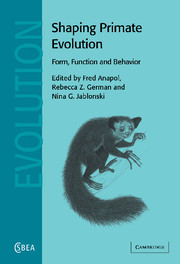Book contents
- Frontmatter
- Contents
- List of contributors
- Preface: shaping primate evolution
- 1 Charles Oxnard: an appreciation
- Part I Craniofacial form and variation
- 2 The ontogeny of sexual dimorphism: the implications of longitudinal vs. cross-sectional data for studying heterochrony in mammals
- 3 Advances in the analysis of form and pattern: facial growth in African colobines
- 4 Cranial variation among the Asian colobines
- 5 Craniometric variation in early Homo compared to modern gorillas: a population-thinking approach
- Part II Organ structure, function, and behavior
- Part III In vivo organismal verification of functional models
- Part IV Theoretical models in evolutionary morphology
- Part V Primate diversity and evolution
- Index
- References
4 - Cranial variation among the Asian colobines
Published online by Cambridge University Press: 10 August 2009
- Frontmatter
- Contents
- List of contributors
- Preface: shaping primate evolution
- 1 Charles Oxnard: an appreciation
- Part I Craniofacial form and variation
- 2 The ontogeny of sexual dimorphism: the implications of longitudinal vs. cross-sectional data for studying heterochrony in mammals
- 3 Advances in the analysis of form and pattern: facial growth in African colobines
- 4 Cranial variation among the Asian colobines
- 5 Craniometric variation in early Homo compared to modern gorillas: a population-thinking approach
- Part II Organ structure, function, and behavior
- Part III In vivo organismal verification of functional models
- Part IV Theoretical models in evolutionary morphology
- Part V Primate diversity and evolution
- Index
- References
Summary
Introduction
Variation in cranial measurements between species has been commonly used to shed light on controversies in the classification, evolution, phylogeny, and functional adaptation of primates. Variation within species has also been used frequently to reveal differences between populations or sexes in morphology, social activities, behavior, ancestral heritage, size, and sexual selection (e.g., Leutenegger and Kelly, 1977; Oxnard, 1983a; Cheverud et al., 1985; Albrecht and Miller, 1993). Studies involving both inter- and intraspecific variation simultaneously are, however, rare (Pan, 1998; Pan and Oxnard, 2000, 2001a). This approach has proven useful in revealing patterns of variation in different functional units or anatomic regions in the same organ (e.g., skull) and in the analysis of the relationship between species or species groups in terms of shape and functional adaptation of various structures. Such studies, although clearly phenetic, have the potential to shed useful light on controversies relating to phylogeny and classification, especially of closely related primate taxa. Previous studies examining inter- and intraspecific variation were carried out on macaques (Pan, 1998; Pan and Oxnard, 2000, 2001a). In this study, the same approach is applied to the Asian colobines because they appear to have evolved in the same places and roughly at the same time as the macaques, and their evolution was probably influenced by many of the same environmental changes during the Pliocene and Pleistocene (Pan and Jablonski, 1987; Jablonski, 1993).
Asian colobines have been a highly successful radiation, as judged by their diversity and wide distribution.
- Type
- Chapter
- Information
- Shaping Primate EvolutionForm, Function, and Behavior, pp. 45 - 65Publisher: Cambridge University PressPrint publication year: 2004
References
- 2
- Cited by

